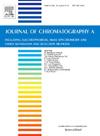Determination of anthraquinones in Frangula alnus by Supercritical Fluid Chromatography
IF 3.8
2区 化学
Q1 BIOCHEMICAL RESEARCH METHODS
引用次数: 0
Abstract
Anthraquinones are the major bioactive compounds in alder buckthorn, a plant with a long history of use for the treatment of obstipation in European and Asian traditional medicine. As these metabolites are also associated with toxic side effects, reliable analytical techniques for their determination are essential. Previously described methods mainly utilized Liquid Chromatography for this purpose, as the photometric assay described in the current edition of the European Pharmacopoeia lacks selectivity. In this study, the development and application of an alternative approach, Ultra-High Performance Supercritical Fluid Chromatography, is presented, facilitating the qualitative and quantitative determination of seven anthraquinone derivatives in under six minutes. This was possible by using a Torus™ DIOL column and a modifier comprising methanol with 10 % acetonitrile and 2.5 mM oxalic acid; applying a flow rate of 1.6 mL/min and an elevated temperature of 55 °C enabled optimal resolution. Regarding selectivity, linearity (R2 ≥ 0.9995), precision and accuracy (recovery rates between 96.6 and 103.3 %), all results were in line with the respective ICH requirements. Practical applicability of the assay was confirmed by analyzing different samples, including commercially available plant material, phytopharmaceuticals containing Frangula bark and wild collected samples. Except of the latter, glucofrangulin A always was the dominating compound; however, the overall anthraquinone content showed to be very variable ranging from 2.18 to 51.32 mg.
超临界流体色谱法测定欧鼠李中的蒽醌类化合物
蒽醌类化合物是赤杨中的主要生物活性化合物,在欧洲和亚洲的传统医学中,这种植物被用于治疗便秘的历史悠久。由于这些代谢物也会产生毒副作用,因此必须采用可靠的分析技术对其进行测定。以前描述的方法主要是利用液相色谱法来实现这一目的,因为现行版《欧洲药典》中描述的光度测定法缺乏选择性。本研究介绍了一种替代方法--超高效超临界流体色谱法--的开发和应用情况,该方法可在 6 分钟内对 7 种蒽醌衍生物进行定性和定量测定。该方法采用 Torus™ DIOL 色谱柱和由甲醇加 10 % 乙腈和 2.5 mM 草酸组成的改性剂;流速为 1.6 mL/min,温度升至 55 ℃,从而实现了最佳的分辨率。在选择性、线性(R2 ≥ 0.9995)、精密度和准确度(回收率在 96.6% 和 103.3% 之间)方面,所有结果均符合相应的 ICH 要求。通过分析不同的样品,包括市售植物材料、含佛手树皮的植物药和野生采集样品,证实了该检测方法的实用性。除后者外,葡萄糖桔皮苷 A 始终是主要化合物;然而,总体蒽醌含量变化很大,从 2.18 毫克到 51.32 毫克不等。
本文章由计算机程序翻译,如有差异,请以英文原文为准。
求助全文
约1分钟内获得全文
求助全文
来源期刊

Journal of Chromatography A
化学-分析化学
CiteScore
7.90
自引率
14.60%
发文量
742
审稿时长
45 days
期刊介绍:
The Journal of Chromatography A provides a forum for the publication of original research and critical reviews on all aspects of fundamental and applied separation science. The scope of the journal includes chromatography and related techniques, electromigration techniques (e.g. electrophoresis, electrochromatography), hyphenated and other multi-dimensional techniques, sample preparation, and detection methods such as mass spectrometry. Contributions consist mainly of research papers dealing with the theory of separation methods, instrumental developments and analytical and preparative applications of general interest.
 求助内容:
求助内容: 应助结果提醒方式:
应助结果提醒方式:


